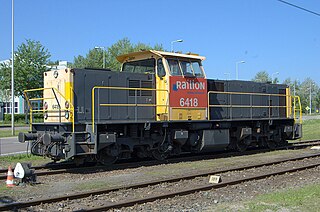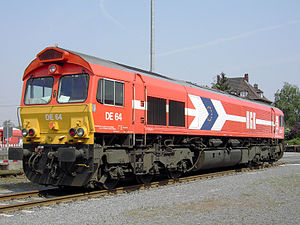
DB Cargo UK, is a British rail freight company headquartered in Doncaster, England.

The British Rail Class 57 is a type of diesel locomotive that was remanufactured from Class 47s by Brush Traction of Loughborough between 1998 and 2004.

The Class 66 is a type of six-axle diesel-electric freight locomotive developed in part from the Class 59, for use on the railways of the UK. Since its introduction the class has been successful and has been sold to British and other European railway companies. In Continental Europe it is marketed as the EMD Class 66 (JT42CWR).

The Class 67 locomotives are a class of Bo-Bo diesel-electric locomotives that were built for the English Welsh & Scottish Railway (EWS) between 1999 and 2000 by Alstom at Meinfesa in Valencia, Spain with drive components from General Motors' Electro-Motive Division.

An electro-diesel locomotive is a type of locomotive that can be powered either from an electricity supply or by using the onboard diesel engine. For the most part, these locomotives are built to serve regional, niche markets with a very specific purpose.

The British Rail Class 59 is a fleet of Co-Co diesel-electric locomotives built between 1985 and 1995 by the Electro-Motive Division of General Motors for use in Great Britain. A total of 15 locomotives were built for three different operators.

The NS Class 6400 is a type of 4 axle diesel-electric freight locomotive. 120 were built by MaK and ABB between 1988 and 1994 for Nederlandse Spoorwegen.

DB Cargo France is a French rail freight operator. It is presently a subsidiary of the German state-owned logistics company DB Cargo.

The Indian locomotive class WDG-4 is a type of six-axle (Co-Co) freight-hauling diesel-electric locomotive with AC electric transmission designed by General Motors Electro-Motive Diesel in 1997–1998 for Indian Railways, where they are classed as WDG-4. Derived from the EMD SD70MAC, it is powered by a 4,000 hp (3,000 kW) 16-cylinder EMD 710G3B prime mover. Thirteen were built by EMD as order #958647, and a further eight were exported in kit form and assembled in India. The class entered service in 1999. This locomotive is also famous for, and can be identified by the distinct Jet Aeroplane-like sounding capability of its EMD 710 prime mover.

The Indian locomotive class WDP-4 is a passenger-hauling diesel-electric locomotive with AC electric transmission designed by General Motors Electro-Motive Division and built by both GM-EMD and under license by Banaras Locomotive Works (BLW) of Varanasi, India for Indian Railways as the classes WDP4, WDP4B and WDP4D. The GT46PAC is a passenger version of the previous Indian Railways EMD GT46MAC freight locomotive. The locomotive has a 16-cylinder 710G3B diesel engine and is one of the fastest diesel-electric locomotives in service in Indian Railways.

The New South Wales 42 class was a class of diesel locomotives built by Clyde Engineering, Granville for the New South Wales Department of Railways in 1955/56.

The EMD G16 is a diesel locomotive built by General Motors in the US and under licence by Clyde Engineering in Australia and MACOSA in Spain. It has been used in Australia, Brazil, Egyptian Railways, Hong Kong, Israel Railways, Mexico, Spain, Yugoslav Railways and on the successor Croatian Railways, Slovenian Railways, Serbian Railways, Macedonian Railways, Republika Srpska Railways, Kosovo Railways and Railways of the Federation of Bosnia and Herzegovina.

The T class are a class of diesel locomotives built by Clyde Engineering, Granville for the Victorian Railways between 1955 and 1968.

The Stadler Euro is a class of diesel-electric locomotives built by Stadler Rail for the European market. It is available in two basic variants, the four-axle Euro 3000, and the six-axle Euro 4000. These locomotives are powered by EMD 710 prime movers. A six-axle electric-only variant is marketed as Euro 6000; it is also built for the Iberian gauge.

The Spoornet Class 39-000 of 2006 is a South African diesel-electric locomotive from the Spoornet era.

The Córas Iompair Éireann/Iarnród Éireann 071 Class or Northern Ireland Railways 110 Class or Serbian Railways JŽ series 666 is a General Motors Electro-Motive Division EMD JT22CW series diesel-electric locomotive used in the Republic of Ireland, Northern Ireland and Serbia.

The Transnet Freight Rail Class 43-000 of 2011 is a South African diesel-electric locomotive.

The GE PowerHaul is a class of mainline diesel-electric locomotives designed by General Electric. Thirty locomotives were ordered by Freightliner in 2007; the first locomotive was completed in July 2009 at GE's Erie, Pennsylvania, plant.

Beacon Rail is a rolling stock company (ROSCO) based in the United Kingdom. Its primary business is the leasing of locomotives and rolling stock to various train operating companies (TOCs).

Bangladesh Railway Class 3000 is a class of meter-gauge diesel-electric locomotives operated by Bangladesh Railway. This is the latest and most modern meter gauge locomotive class of the Bangladesh Railway. These locos could be used on broad gauge track also by changing bogies.






















